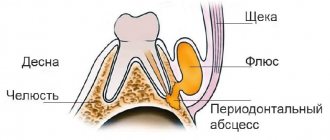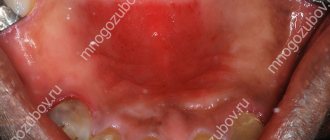Dentists are one of the few doctors whose visits patients prefer to postpone. Therefore, treatment of advanced caries is not uncommon. If the tooth is severely involved, it is usually necessary to remove the nerve. For this purpose, arsenic-based paste is used. Sometimes even after all the manipulations, the toothache does not go away. We will look into the reasons for this condition in today’s article.
When is it necessary to remove a nerve?
Dentists are trying their best to save the tooth, but, unfortunately, this is not always possible. For example, in case of extensive caries, it is necessary to resort to removing the nerve of the tooth. The nerve (pulp) is responsible for the sensitivity of the unit. Pain and other unpleasant symptoms arise precisely because of inflammation of the pulp. The following conditions are considered the main indications:
- Advanced periodontitis.
- Deep caries affecting the internal tissues of the tooth.
- Acute pulpitis.
Also, this manipulation is indicated in cases where crowns, bridges, veneers and other fixed prostheses are to be installed. First of all, this is done with the intention that the tooth does not get sick under the artificial structure. In this case, the unit is considered dead, but continues to perform its functional duties.
The fourth reason is the individual reaction of the body
The reason is rare, but do not forget that each person is individual. A long-term or acute painful reaction can occur both to arsenic anhydride itself and to the auxiliary components included in the paste. Most often, pain occurs due to a lowered pain threshold and the patient’s tendency to allergic reactions.
Pain may occur due to allergies and individual intolerances
“Once in my youth I had pulpitis, the doctor put medicine inside to kill the nerve and didn’t even say whether the tooth with arsenic should hurt. He told me to come for an appointment only in a few days. There was no Internet back then, and we took the doctors’ word for it. I came home in blissful ignorance, and after about two hours the pain began to be so severe that I wanted to climb the wall. Analgin did not help to remove it, so the next day I ran back to the hospital begging them to do something. And the doctor looked at me in such surprise, saying, I’m kind of wild, and he almost pushed me out of the office, saying, I have to walk for another day. But it turns out that there were only flowers at home - the berries started at the follow-up appointment. The pain not only did not go away, but became even stronger than before. I don’t know how I survived that day. Since then I’ve been trying not to let my teeth get into trouble like that, because... the thought of pulpitis causes terrible experiences.”
Marina Vasilievna, Novocherkassk, review from woman.ru
With individual body reactions, pain may be accompanied by other symptoms: increased body temperature, severe swelling of the mucous membrane. The most dangerous situation is anaphylactic shock due to an acute allergic reaction to the drug, therefore, if the condition sharply worsens after installing a filling with arsenic, it is better to immediately call an ambulance.
How does arsenic remove a nerve?
Note that removing pulp using arsenic is an outdated technique. Most often it is practiced in public clinics. First, the patient is sent for an x-ray, then the tooth is processed with a drill and unimpeded access to the nerve of the tooth is created. Next, an arsenic-based paste is placed into the formed bed, and a temporary filling is placed on top. As a rule, it is removed after 1-3 days. After the filling is removed, the canals are cleaned, then a permanent filling is fixed.
The third reason is incorrect calculation of the dosage of the drug
If you are going to treat pulpitis, be sure to contact only experienced specialists. After all, there are often cases of medical errors when the doctor, when putting the drug into the tooth cavity, makes a mistake with the dosage of the paste, does not take into account the patient’s age, the condition of the nerve and the size of the tooth.
The situation when you put arsenic on a tooth, and it hurts, can arise both in the case of an insufficient amount of the drug, and in the case of an excess of it. In the first situation, the paste was not enough to “kill” the sensory nerve, which is why it hurts. Experts call this condition “residual pulpitis.” In the second situation, pain is evidence of irritation of the periodontal tissues and the toxicological effect of an overdose of the drug.
Does it hurt?
In most cases, the process of pulp necrosis using arsenic is painless. This is due to the pain-relieving components that are present in the arsenic paste. Sometimes patients complain of moderate pain, and this is normal. If you are experiencing severe pain, we recommend that you immediately visit the dentist.
Significant pain is possible if the dentist violated the rules for performing this procedure, for example, put too little arsenic.
Comments
During an examination in kindergarten, the doctor recently diagnosed my daughter with pulpitis of a baby tooth. He spoke with the teachers, mostly in terms of the same terms, and suggested devital amputation of the dental pulp. I wrote out a recommendation to go to the clinic. Then I started reading on the Internet and became even more confused - how does devital differ from vital? How is amputation different from extirpation?
Ekaterina (11/23/2019 at 2:26 pm) Reply to comment
- Dear Ekaterina, the devital method involves first killing the nerve of the tooth using special arsenic pastes, and then extracting it. Vital involves removing the nerve in one visit to the doctor without the use of pastes under a powerful anesthetic. As for amputation, amputation is most often used in children and involves partial removal of the pulp (the coronal part is preserved, but the root part is removed, then the cavity is filled with a special paste that mummifies the remaining part of the pulp to prevent further spread of infection). The nerve is partially removed so that the roots of the tooth can grow, develop, and receive adequate nutrition. During extirpation, both the coronal and root parts of the pulp are removed - this method is used in adults.
Editorial staff of the portal UltraSmile.ru (11/26/2019 at 09:13) Reply to comment
I remember back in my teens I decided to go to the local dentistry in the area, students were just doing an internship there, in general, in order to kill the nerve, they put arsenic on me, but they didn’t make a hermetically sealed filling, in the morning I went to a private clinic, why in public clinics until Is this method still used?
Alexander93 (12/10/2019 at 10:51 am) Reply to comment
My tooth ached, they drilled it out and said that it was necessary to put arsenic, which they did. They told me to come after the weekend. I had such pain in this tooth that I wanted to call an ambulance. On Monday they said that the arsenic had no effect and the nerves were removed live. Why did it happen? Doctor's mistake?
Irina (12/10/2019 at 2:16 pm) Reply to comment
The doctor placed arsenic under the teenager’s filling in order to kill the nerve. But the tooth has been hurting very badly for the second day now. How long will such pain last, and is it dangerous for arsenic to remain under the filling for a long time?
Elvira (12/10/2019 at 7:37 pm) Reply to comment
The doctor put a little arsenic under the filling for the girl, several days have already passed, and the pain is still present, although the doctor himself claimed that the nerve would die within 24 hours. What causes this toothache then, and how can it be relieved?
Olga Rolenko (12/11/2019 at 01:24) Reply to comment
Hello, I have the following question. My son was diagnosed with tooth pulpitis. What to do? Tear out? Or is there a way to cure it painlessly? Waiting for your reply. Thank you.
Zhanna (12/11/2019 at 01:31 pm) Reply to comment
About 5 months ago I went to the dentist to have tooth decay treated. I also often have stomatitis and my gums become inflamed. The doctor put arsenic on one tooth, and everything with that tooth seemed to be fine afterwards. Then she examined another tooth another time and said that I had pulpitis, and suggested putting arsenic first. But then they took a picture and said it was better to remove the nerve. Removed it the same day. But to this day I still have pain when chewing, even though the nerve was removed. Almost half a year has passed. I took a picture twice and everything was clean on it. The doctor examined me and didn’t see anything either. What could this be connected with, how can I find out the reason if two dentists found nothing? Or was it also necessary to first administer arsenic before removing the nerve?
Marina (12/11/2019 at 6:31 pm) Reply to comment
I don’t understand how, with the current level of development of medicine (and dentistry in particular), it is possible to use such a dangerous substance as arsenic. After all, there are alternatives to arsenic paste? Or is there no other way to cure pulpitis? I would like to clarify this issue for the future.
Irina (12/11/2019 at 6:46 pm) Reply to comment
Hello! I have a tooth problem. A long time ago, back in school, I had a filling installed, after 4 years I had repeated caries, the filling fell out. Now it has begun to crumble, the gums are swollen and red. The tooth is a little loose. Is it worth treating it or is it better to remove it immediately?
Larisa Novikova (02/06/2020 at 17:06) Reply to comment
Please tell me, can there be an allergy to such a temporary filling with arsenic? And should the doctor warn me in advance that he will put arsenic in my tooth, which is actually poisonous...
Regina (03/16/2020 at 10:55 am) Reply to comment
At one time, I had more than one tooth treated using arsenic at the initial stage of treatment. I was lucky and never had any complications. But now my son has been given arsenic and he has been complaining of severe pain for three days now. On what day should the pain go away if everything is fine? His follow-up appointment is only in three days, is it worth going earlier?
Angelina (03/16/2020 at 05:49 pm) Reply to comment
Why, when treating a multi-rooted tooth, did the doctor prescribe sessions for me 6-7 days apart, gradually apply the medicine three times, and I constantly felt pain for a long period? Is it normal that after completing treatment, the tooth hurts for another week?
Vyacheslav (04/23/2020 at 07:48) Reply to comment
I have several questions: 1. Is it possible to “kill” the dental nerve simply by applying arsenic? 2. If arsenic does not work and the nerve is still sensitive, can a filling be placed? 3. At what age does a child have a nerve removed before a filling? Is there an age limit?
Jean (04/23/2020 at 08:03) Reply to comment
I would also like to know for what reasons arsenic may not work at all. And then something like this happens: you suffer for 5 days, you go to the doctor, and the nerve is removed alive. And then one asks why he gave the money and suffered
Andrey (04/23/2020 at 08:53) Reply to comment
I had to deal with arsenic treatment, which was not a very pleasant feeling. The first day the tooth ached, I had to numb it. What modern methods of treating pulpitis without arsenic exist? Which ones do you recommend?
Svetlana Yuryevna (04/23/2020 at 10:59 am) Reply to comment
friday after leaving mysnyak tooth aches what are they dividing
Maxim (13.10.2021 at 14:57) Reply to comment
they gave a ticket on October 18, the blom's teeth ache at work
Maxim (10/13/2021 at 02:58 pm) Reply to comment
Write your comment Cancel reply
Further recommendations
When arsenic is present, the following rules must be followed:
- It is not recommended to use painkillers.
- Do not try to heat the tooth, even if it hurts. Such measures can lead to complications.
- For three hours after the temporary filling is installed, try to refrain from eating and drinking.
- Do not rinse your mouth.
If the doctor claims that it is necessary to resort to the removal of the dental nerve, there is no need to panic or refuse this procedure. If this is not done in a timely manner,
the tooth
removed completely. Even after depulpation, the tooth will last for many years.
First aid
To relieve pain, you must take any non-steroidal anti-inflammatory drug. The most popular are Diclofenac, Ibuprofen and Nurofen. They not only have an analgesic effect, but also have an anti-inflammatory and pronounced antipyretic effect. If there are none in your home medicine cabinet, you can drink regular Analgin. Any pills should be taken only after reading the instructions and studying possible contraindications.
It is not recommended to self-medicate and try recipes from traditional healers. Do not apply dry heat to the affected area. If the pain cannot be tolerated and a visit to the dentist is postponed, you should try to extract the arsenic paste yourself. Just follow the steps below:
- First you need to prepare a regular needle, first rinse it with any disinfectant.
- Then you need to brush your teeth with toothpaste and rinse your mouth well.
- If the temporary filling has not yet fallen out on its own at this stage, it can be picked out with a needle. It is important not to touch the soft gum tissue.
- A small gray ball will be easily visible under the filling. You need to carefully pry the paste ball with a needle and try to pull it out.
- After all manipulations, rinsing with a decoction of chamomile or soda is recommended. You can add a small amount of peroxide to the liquid.
- At the final stage, the open tooth cavity should be closed with a cotton swab.
After all the manipulations, it is important to contact the dentist as soon as possible. An open dental canal is an easy way for any infection to enter. Before visiting a doctor, you should try not to eat or drink.
Arsenic during pregnancy and in pediatric dentistry
Often, tooth root removal is required for pregnant women or children. During pregnancy and the appearance of milk units, the paste is used very rarely.
- Firstly, the issue of the effect of toxins on the delicate roots of temporary teeth and the embryo has not been sufficiently studied.
- Secondly, it is difficult to correctly calculate the tiny dose for children.
- Thirdly, a child may accidentally swallow the fallen paste.
Therefore, the substance is used only as a last resort when the patient is allergic to anesthesia. Due to high risks, the toxic substance is replaced with a safe one. When the pediatric dentist is forced to use the paste, its action time is reduced to a minimum. In other cases, alternative pulp necrotization technologies are used.
Contraindications to the use of arsenic paste
It is not always allowed to use arsenic paste as an anesthetic. The main contraindication is hypersensitivity to its composition. Also, doctors do not recommend using the drug in the following situations:
- children under 1.5 years of age;
- the roots have not yet fully formed;
- the dental canals are poorly cleaned, it is not possible to carry out a complete sanitation of the oral cavity;
- the presence of artificial holes in the root;
- increased intraocular pressure;
- pathologies of the urinary system;
- period of pregnancy and lactation.
Restrictions that apply to children, pregnant and lactating women are completely justified. In this category of patients, treatment is carried out using other methods. Even a small dose of arsenic, if it enters the gastrointestinal tract, can cause undesirable consequences.
Despite the rapid development of dentistry, dentists still actively use arsenic in their practice. In the hands of an experienced specialist, this substance allows you to carry out therapy without severe pain. The main thing is to follow all the doctor’s recommendations after adding arsenic paste and possible restrictions, and if uncharacteristic symptoms appear, you need to seek medical help again.
The dangers of arsenic paste
In modern dentistry, arsenic paste is used exclusively for indications. If the dosage is violated, the recommendations of specialists or in the case of individual characteristics of the body, its toxic properties may appear. In addition, the following complications may occur:
- swelling of the pulp;
- development of progressive periodontitis;
- darkening of dentin;
- necrotization of the periosteum;
- intoxication of internal organs.
Experts do not recommend using arsenic paste when treating pregnant women. It is also used with caution in pediatric dentistry. For these categories of patients, other, newer options for treating pulpitis are used.











